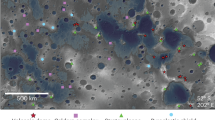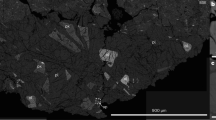Abstract
The mineralogical diversity preserved on ancient terrains of Mars provides insights into the planet’s early geological state and subsequent evolution. The martian crust is predominantly composed of mafic rocks with low silica contents1,2,3,4,5,6, with the exception of a few localized volcanic sequences that indicate some compositional evolution towards compositions richer in silicate minerals2. Anorthosite, which is dominated by the silicate mineral plagioclase, is rare in the Solar System. It is thought to require an evolved magmatic source in which lighter elements have been concentrated. Anorthosite has been observed previously only on Earth within localized continental plutons of intrusive igneous origin7, and more widely on the Moon8 where the anorthositic highland crust is thought to derive from crystallization of a primordial magma ocean9,10. Using near-infrared spectral data obtained by the Mars Reconnaissance Orbiter, we report the detection of iron-bearing plagioclase-rich rocks at eight sites in the southern highlands of Mars with a spectral signature consistent with ferroan anorthosites. The paucity of detections suggests a localized plutonic origin similar to terrestrial anorthosites, although a lunar-like global anorthosite crust on early Mars cannot be entirely excluded. Our detections of anorthositic compositions at several locations on the martian surface suggest that magmatic processes that produce highly evolved melts were active on ancient Mars.
This is a preview of subscription content, access via your institution
Access options
Subscribe to this journal
Receive 12 print issues and online access
$259.00 per year
only $21.58 per issue
Buy this article
- Purchase on Springer Link
- Instant access to full article PDF
Prices may be subject to local taxes which are calculated during checkout




Similar content being viewed by others
References
Bandfield, J. L., Hamilton, V. E. & Christensen, P. R. A global view of Martian surface compositions from MGS-TES. Science 287, 1626–1630 (2000).
Christensen, P. et al. Evidence for magmatic evolution and diversity on Mars from infrared observations. Nature 436, 504–509 (2005).
Mustard, J. F. et al. Olivine and pyroxene diversity in the crust of Mars. Science 307, 1594–1597 (2005).
McSween, H. Y. et al. Characterization and petrologic interpretation of olivine-rich basalts at Gusev Crater, Mars. J. Geophys. Res. 111, E02S10 (2006).
Poulet, F. et al. Quantitative compositional analysis of martian mafic regions using the MEx/OMEGA reflectance data. 2. Petrological implications. Icarus 201, 84–101 (2009).
Milam, K., McSween, H., Moersch, J. & Christensen, P. Distribution and variation of plagioclase compositions on Mars. J. Geophys. Res. 115, E9 (2010).
Ashwal, L. The temporality of anorthosites. Can. Mineral. 48, 711–728 (2010).
Ohtake, M. et al. The global distribution of pure anorthosite on the Moon. Nature 461, 236–240 (2009).
Warren, P. H. The magma ocean concept and lunar evolution. Annu. Rev. Earth Planet. Sci. 13, 201–240 (1985).
Wood, J. et al. Lunar anorthosites and a geophysical model of the moon. Proc. Lunar Planet. Sci. Conf. I, 965 (1970).
Elkins-Tanton, L., Hess, P. & Parmentier, E. Possible formation of ancient crust on Mars through magma ocean processes. J. Geophys. Res. 110, E12 (2005).
Murchie, S. et al. Compact Reconnaissance Imaging Spectrometer for Mars (CRISM) on Mars Reconnaissance Orbiter (MRO). J. Geophys. Res. 112, E5 (2007).
Crown, D. A. & Pieters, C. M. Spectral properties of plagioclase and pyroxene mixtures and the interpretation of lunar soil spectra. Icarus 72, 492–506 (1987).
Charette, M. P. & Adams, J. B. Spectral reflectance of lunar highland rocks. Lunar Planet. Sci. Conf. 8, 172–174 (1977).
Adams, J. & Goullaud, L. Plagioclase feldspars: Visible and near-infrared diffuse reflectance spectra as applied to remote sensing. Proc. Lunar Planet. Sci. Conf. 9, 2901–2909 (1978).
Cheek, L. C., Donaldson Hanna, K. L., Pieters, C. M., Head, J. W. & Whitten, J. L. The distribution and purity of anorthosite across the Orientale basin: New perspectives from Moon Mineralogy Mapper data. J. Geophys. Res. 118, 1805–1820 (2013).
Bishop, J., Lane, M., Dyrar, M. & Brown, A. Reflectance and emission spectroscopy study of four groups of phyllosilicates: Smectites, kaolinite-serpentines, chlorites and micas. Clay Miner. 43, 35–54 (2008).
Anbazhagan, S. & Arivazhagan, S. Reflectance spectra of analog anorthosites: Implications for lunar highland mapping. Planet. Space Sci. 58, 752–760 (2010).
Johnson, J. R. & Horz, F. Visible/near-infrared spectra of experimentally shocked plagioclase feldspars. J. Geophys. Res. 108, E11 (2003).
Leonard, G. & Tanaka, K. Geologic Map of the Hellas Region of Mars, Geologic Investigations Series I-2694 (US Geological Survey, 2001).
Putzig, N. & Mellon, T. Apparent thermal inertia and the surface heterogeneity of Mars. Icarus 191, 68–94 (2007).
Shearer, C. & Papike, J. Magmatic evolution of the Moon. Am. Mineral. 84, 1469–1494 (1999).
Hawke, B. et al. Distribution and modes of occurrence of lunar anorthosite. J. Geophys. Res. 108, E6 (2003).
Borg, L. & Draper, D. A petrogenic model for the origin and compositional variation of the martian basaltic meteorites. Meteorit. Planet. Sci. 38, 1713–1731 (2003).
Wray, J. et al. Prolonged magmatic activity on Mars inferred from the detection of felsic rocks. Nature Geosci.http://dx.doi.org/10.1038/ngeo1994 (2013).
Ashwall, L. Anorthosites (Springer, 1993).
Winter, J. An Introduction to Igneous and Metamorphic Petrology (Prentice Hall, 2001).
Clarke, D. B. Granitoid Rock (Chapman and Hall, 1992).
Carter, J., Poulet, F., Mangold, N., Bibring, J-P. & Murchie, S. Hydrous minerals on Mars as seen by the CRISM and OMEGA imaging spectrometers: Updated global view. J. Geophys. Res. 118, 831–858 (2013).
Velde, B. Origin and Mineralogy of Clays: Clays and the Environment (Springer, 2010).
Carter, J., Poulet, F., Murchie, S. & Bibring, J-P. Automated processing of planetary hyperspectral datasets for the extraction of weak mineral signatures and applications to CRISM observations of hydrated silicates on Mars. Planet. Space Sci. 76, 53–67 (2013).
Acknowledgements
We would like to thank B. Horgan for a thorough review that greatly improved the manuscript.
Author information
Authors and Affiliations
Contributions
J.C. jointly conceived this study with F.P. The observational strategy, data reduction and data analysis were performed by J.C. Both authors wrote the paper and interpreted the results.
Corresponding author
Ethics declarations
Competing interests
The authors declare no competing financial interests.
Supplementary information
Supplementary Information
Supplementary Information (PDF 486 kb)
Rights and permissions
About this article
Cite this article
Carter, J., Poulet, F. Ancient plutonic processes on Mars inferred from the detection of possible anorthositic terrains. Nature Geosci 6, 1008–1012 (2013). https://doi.org/10.1038/ngeo1995
Received:
Accepted:
Published:
Issue Date:
DOI: https://doi.org/10.1038/ngeo1995
This article is cited by
-
Volcanism in the Solar System
Science China Earth Sciences (2023)
-
Present-day heat flow model of Mars
Scientific Reports (2017)
-
Mars: a small terrestrial planet
The Astronomy and Astrophysics Review (2016)
-
In situ evidence for continental crust on early Mars
Nature Geoscience (2015)
-
Prolonged magmatic activity on Mars inferred from the detection of felsic rocks
Nature Geoscience (2013)



